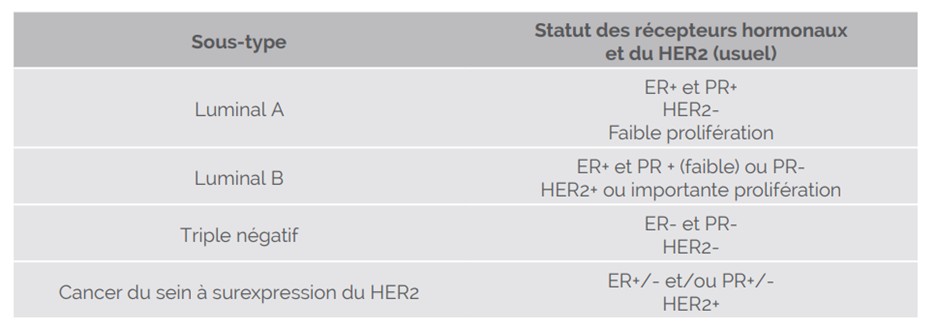By continuing to use our site, you consent to the processing of cookies, user data (location information, type and version of the OS, the type and version of the browser, the type of device and the resolution of its screen, the source of where the user came from, from which site or for what advertisement, language OS and Browser, which pages are opened and to which buttons the user presses, ip-address) for the purpose of site functioning, retargeting and statistical surveys and reviews. If you do not want your data to be processed, please leave the site.
La voix des personnes atteintes d'un cancer du sein
Information
Notions de base sur le cancer
Sous-types de cancer du sein
Le cancer du sein varie selon sa manière de se développer et sa réponse au traitement. Certaines tumeurs croissent rapidement, tandis que d’autres se développent plus lentement. Pour mieux comprendre le comportement d’une tumeur et la manière de la traiter, les équipes soignantes classent le cancer du sein selon des biomarqueurs — des caractéristiques biologiques particulières identifiées grâce à des analyses en laboratoire.
Les deux principaux biomarqueurs analysés dans le cadre du diagnostic du cancer du sein sont le statut des récepteurs hormonaux (RH) et le statut du récepteur 2 du facteur de croissance épidermique humain (HER2). Les équipes soignantes s’appuient sur ces éléments, ainsi que sur le stade et le grade de la tumeur, pour orienter les décisions thérapeutiques. En plus de ces biomarqueurs, le cancer du sein peut également être classé en sous-types moléculaires.
Remarque : le sous-type de cancer peut changer avec le temps. Dans 20 à 30 % des cas, il peut changer si le cancer récidive ou s’il se propage.
Qu’est-ce que le statut des récepteurs hormonaux (RH)?
Certaines cellules cancéreuses ont des récepteurs (protéines sur ou dans les cellules) qui s’attachent à des hormones : les œstrogènes, ou la progestérone. Ces hormones peuvent contribuer au développement des cellules cancéreuses.
Les cellules du cancer du sein peuvent avoir une combinaison de ces récepteurs :
- Récepteur aux œstrogènes (ER) positif : présence de récepteurs aux œstrogènes
- Récepteur à la progestérone (PR) positif : présence de récepteurs à la progestérone
- Récepteur aux œstrogènes (ER) positif et récepteur à la progestérone (PR) positif : présence des deux types de récepteurs
Lorsque les cellules du cancer du sein expriment l’un de ces récepteurs, ou les deux, on parle de récepteur aux œstrogènes (ER) positif. En cas d’absence de ces récepteurs, on parle alors de récepteur aux œstrogènes (ER) négatif.
Pourquoi le statut RH est-il important?
-
Le blocage de ces hormones à l’aide d’une thérapie peut ralentir ou arrêter la progression du cancer.
- Les cancers RH+ croissent plus lentement et répondent bien à l’hormonothérapie.
- Les cancers RH- croissent plus rapidement, ne répondent pas à l’hormonothérapie et nécessitent souvent une chimiothérapie.
- Environ 75 % des cancers du sein ont au moins un récepteur hormonal et les cancers du sein RH+ sont plus répandus chez les adultes plus âgés.
Qu’est-ce que le statut HER2?
La protéine HER2 est une protéine présente sur les cellules mammaires qui aide à réguler la croissance cellulaire. Le gène HER2 contrôle la quantité de protéine HER2 produite par une cellule.
- Les cellules mammaires normales possèdent deux copies du gène HER2 et des niveaux normaux de protéine HER2.
- Le cancer du sein HER2+ comporte des copies supplémentaires du gène HER2, ce qui entraîne une production excessive de la protéine HER2 et une croissance non contrôlée des cellules.
Pourquoi le statut HER2 est-il important?
-
Les médecins testent le statut HER2 sur le tissu tumoral pour décider des options thérapeutiques.
- Les cancers HER2+ croissent plus rapidement que les cancers HER2- . Ils répondent bien aux thérapies ciblées, comme le trastuzumab (Herceptin) et le pertuzumab (Perjeta).
- Le statut HER2 peut changer avec le temps, en particulier après le traitement, en cas de récidive ou de métastases, ce qui exige un nouvel examen.
Sous-types moléculaires de cancer du sein invasif
En plus des classifications cliniques basées sur les statuts RH et HER2, le cancer du sein peut aussi se classer selon le sous-type moléculaire. Ces sous-types se basent sur les protéines et les gènes présents dans les cellules, ce qui aide à prédire comment le cancer pourrait se développer et répondre au traitement.
Les principaux sous-types moléculaires comprennent :
- Luminal A (RH positif/HER2 négatif) : croissance lente et faible niveau du marqueur de croissance cellulaire Ki-67
- Luminal B (RH positif/HER2 positif ou HER2 négatif) : croissance plus rapide et niveau plus élevé du marqueur Ki-67
- HER2-Enrichi (HER2 positif) : HER2 positif, HR négatif (ER négatif, PR négatif)
- Triple négatif/Basal-Like (CSTN) : ER négatif, PR négatif et HER2 négatif. Plus répandu chez les jeunes, les Noirs et les personnes porteuses du gène BRCA1.
Pourquoi les sous-types moléculaires sont-ils importants?
Les sous-types moléculaires aident à prédire le comportement de la tumeur et à orienter les décisions thérapeutiques. Bien qu’ils ne figurent pas toujours dans les rapports de pathologie, ils sont essentiels dans le domaine de la médecine de précision et pour le développement de thérapies ciblées.
Chaque sous-type est assorti de caractéristiques distinctes et d’approches thérapeutiques particulières.
Les pages suivantes détaillent ces sous-types et leur impact sur la prise en charge des patients.
Révision médicale par le Dr Roochi Arora, MD, FRCPC, août 2025
- References
-
American Cancer Society. (2025). Breast cancer HER2 status. https://www.cancer.org/cancer/types/breast-cancer/understanding-a-breast-cancer-diagnosis/breast-cancer-HER2-status.html
American Cancer Society. (2021). Breast cancer hormone receptor status. https://www.cancer.org/cancer/types/breast-cancer/understanding-a-breast-cancer-diagnosis/breast-cancer-hormone-receptor-status.html
Réseau canadien du cancer du sein. (2022). Le cancer du sein et vous : un guide pour les personnes vivant avec le cancer du sein [PDF]. https://cbcn.ca/web/default/files/public/
Reports/Breast%20Cancer%20and%20You_
FR_edit_web.pdfRéseau canadien du cancer du sein. (2014). Know your type [Infographie]. https://cbcn.ca/web/default/files/public/
Reports/Know%20Your%20Type%20
Infographic%20ENGLISH%20(September%
2030%2C%202014).pdfDePolo, J. (2025). Breast cancer hormone receptor status. Breastcancer.org. https://www.breastcancer.org/pathology-report/hormone-receptor-status
DePolo, J. (2024). Molecular subtypes of breast cancer. Breastcancer.org. https://www.breastcancer.org/types/
molecular-subtypesMcAnena, P. F., McGuire, A., Ramli, A., Curran, C., Malone, C., McLaughlin, R., Barry, K., Brown, J. A. L., & Kerin, M. J. (2018). Breast cancer subtype discordance: Impact on post-recurrence survival and potential treatment options. BMC Cancer, 18(1), 203. https://doi.org/10.1186/s12885-018-4101-7
National Cancer Institute. (2024). Cancer stat facts: Female breast cancer subtypes. National Institute of Health. https://seer.cancer.gov/statfacts/html/
breast-subtypes.htmlNolan-Pleckham, M. (2023). The Ki-67 proliferation marker test and breast cancer treatment. Verywell Health. https://www.verywellhealth.com/ki-67-tumor-marker-test-430609
Orrantia-Borunda, E., Anchondo-Nuñez, P., Acuña-Aguilar, L. E., Gómez-Valles, F. O., & Ramírez-Valdespino, C. A. (2022). Subtypes of breast cancer. In H. N. Mayrovitz (Ed.), Breast Cancer (pp. 31-42). Exon Publications.
Susan G. Komen. (2022). Molecular subtypes of breast cancer. https://www.komen.org/breast-cancer/diagnosis/molecular-subtypes/
Yersal, O., & Barutca, S. (2014). Biological subtypes of breast cancer: Prognostic and therapeutic implications. World Journal of Clinical Oncology, 5(3), 412–424. https://doi.org/10.5306/wjco.v5.i3.412
PARTAGER





